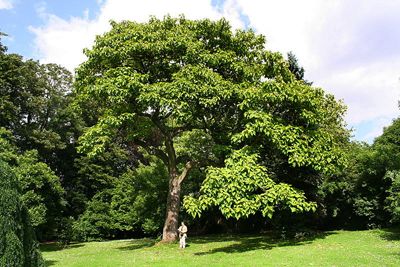by Larry
June, 2015Super Fast Growing Forests
Perhaps with such considerations in mind, Chinese biologists have genetically engineered trees that will grow even faster, be more disease resistant, produce chemicals that are desirable, and so forth. Ironically, such simple seeming solutions come with their own sets of difficulties. Genetically engineered (GE) fast growing forests, for instance, tend to be more monoculture, exhibiting far less diversity of flora or fauna, than naturally occurring, slower growing tree landscapes. Thus, in the shadows of GE forests rare species are becoming even more scarce, perhaps not a good trend in a world that is already seeing the most rapid increase in extinctions since the asteroid considered directly or indirectly responsible for the end of dinosaurs. The concept appears a good one, encouraging trees' rapid growth where they have been lost, yet maybe in this case, as with the tortoise and the hare, slow is beautiful. Additional problems with genetically modified trees have occurred. Their branches and trunks tend to break more easily than with normal trees and particularly more than for slow growing hardwoods. So, structures nearby can be readily damaged by such trees during or following strong winds. Also, just like weeds that grow and easily spread faster than more preferred plants, GE forests can crowd out desirable natural tree varieties along with the wide assortment of plants and animals that had called their forests home. Capitalist proponents of GE tree plantations have engaged in land grab tactics, displacing local economies and human populations in quests for more and more space for profitable timber production and harvesting. Disease resistant trees may give rise to heartier insects that then can go on to endanger natural forests. People are discovering previously unknown allergies to the pollen of GE trees. Monarch butterflies may be more vulnerable to milkweed sprinkled with the wind-borne pollen from GE forests. In third world countries, GE trees are often burned as fuel or to clear areas for agriculture, and smoke pollution has increased, hurting tourism, the health of human and fauna communities, and native flora species. Touting the advantages of biomass sources of energy over mined energy resources, corporations have become great tree pellet producers, with net decreases in other means of livelihood in affected regions. There is hazard too that the pollen of GE trees will cross-fertilize with natural trees, having unforeseen results that could be deleterious to fruit tree orchards, insect resistance, the strength of stands of trees, or their utility for timber production. It is likely that super fast growing trees and trees with other GE characteristics will continue to be approved for tree plantations around the world. They can potentially offer enough benefits in certain circumstances and enough financial incentive in others that they will be a permanent part of the biosphere. Hopefully efforts will also progress apace to limit the larger environmental and economic harm they can do. As Bernd Heinrich said, "Planting tree plantations is permanent deforestation...The extensive planting of just one exotic species removes thousands of native species." (Henrich, B. 2009. The Trees in My Forest. HarperCollins.) This must be at least doubly true for the plantations of genetically modified trees. Primary sources: Genetically Engineered Trees - The New Frontier of Biotechnology. in Center for Food Safety, September, 2013. Paulownia. in Wikipedia, last updated in March, 2012. |
